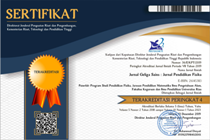Interactive Multimedia Based on Cognitive Conflict to Improve Understanding of Student Concepts in Atomic Nucleus Materials
Abstract
Misconceptions often occur in students because they build their own concepts, which are not in accordance with scientific concepts, including the concept of the atomic nucleus. In schools, there are no IT-based teaching materials that can specifically remediate misconceptions about atomic nuclei and radioactivity. The research was carried out with the aim of making cognitive conflict-based interactive multimedia valid, practical, and effective in small-group evaluations. This research includes design/development research through the use of the Plomp development model, which is limited to 2 stages, namely the preliminary research and the development stage in the small group evaluation. Preliminary research reviewed 3 journals about students' misconceptions about the concept of the atomic nucleus. In the development stage of interactive multimedia design, self-evaluations, expert reviews, one-to-one evaluations, and small-group evaluations were carried out. Data were analyzed descriptively and using the Aiken's-V formula. The results of the self-evaluation of the interactive multimedia design show that it is in the very good category and the average is 83.5. The results of the expert review prove that interactive multimedia design has an average of 0.81 in a very valid category, and has very practical practicality through an average value of 93.1 at the one-to-one evaluation stage and 88.7 at the small stage group evaluation. It can be concluded that the teaching materials in the form of interactive multimedia based on the cognitive conflict in the Atom core material are valid and practical in an effort to support the increase in the conceptual understanding of high school students.
Keywords
Full Text:
PDF (Bahasa Indonesia)References
Adams, W. K., Reid, S., LeMaster, R., McKagan, S. B., Perkins, K. K., Dubson, M., & Wieman, C. E. (2008). A study of educational simulations part IIinterface design. Journal of Interactive Learning Research, 19(4), 55.
Aiken, L.R. (1985). Three Coefficients for analyzing the reliability and validity of ratings. Educational And Psychological Measurement. 45, 131-142.
Delvia, T., Mufit, L., & Bustari, M. (2021). Design and validity of physics teaching materials based on cognitive conflict integrated virtual laboratory in atomic nucleus. Journal: Pillar of Physics Education, 14(1), 5-14.
Depdiknas. (2008). Panduan pengembangan bahan ajar. Jakarta: Dirjen Pendidikan Dasar dan Menengah.
Fadhilah, A., Mufit, F., & Asrizal. (2020). Analisis validitas dan praktikalitas lembar kerja siswa berbasis konflik kognitif pada materi gerak lurus dan gerak parabola. Pillar of Physics Education, 13( 1), 57-64
Hanum, S A, F Mufit. & Asrizal. (2019). Pengembangan LKS berbasis konflik kognitif terintegrasi literasi baru pada materi fluida untuk siswa kelas XI SMA. Pillar Of Physics Education, 12(4), 793-800
Halimin, H., & Retnawati, H. (2015). Analisis miskonsepsi fisika siswa dalam menjawab soal ujian nasional SMA di Kabupaten Buton. Jurnal Evaluasi Pendidikan, 3(2), 123-133.
Imansari, N., & Surnayantiningsih, I. (2017). Pengaruh penggunaan e-modul interaktif terhadap hasil belajar mahasiswa pada materi kesehatan dan keselamatan kerja. VOLT: Jurnal Ilmiah Pendidikan Teknik Elektro, 2(1), 11-16.
Inung, D. & Sekarningsih, N. (2018). Media pembelajaran berbasis multimedia interaktif untuk meningkatkan Pemahaman konsep mahasiswa.
Kemendikbud. (2014). Materi pelatihan implementasi kurikulum 2013 tahun ajaran 2014, mata pelajaran fisika SMA/SMK. Jakarta: tidak diterbitkan.
Kohnle, A., Mclean, S., & Aliotta, M. (2010). Towards a conceptual diagnostic survey in nuclear physics. European Journal of Physics, 32(1),55.
Luthfi, I., Mufit, F., Rosiana, M., & Putri, N. (2020). Design of physics teaching materials based on cognitive conflict learning in direct current electricity integrating virtual laboratory. Pillar of Physics Education, 14(4), 558-567.
Mufit, F., Asrizal, A., & Puspitasari, R. (2020). Meta-analysis of the effect of cognitive conflict on physics learning. Jurnal Penelitian & Pengembangan Pendidikan Fisika (JPPPF) UNJ, 6(2), 267-278.
Mufit, F., & Fauzan, A. (2019). Model pembelajaran berbasis konflik kognitif (PbKK) untuk meningkatkan pemahaman konsep dan meremediasi miskonsepsi. Malang: CV IRDH.
Mufit, F., Festiyed, F., Fauzan, A., & Lufri, L. (2018). Impact of learning model based on cognitive conflict toward student’s conceptual understanding. In IOP Conference Series: Materials Science and Engineering, 335, 012072.
Mufit, F., Asrizal., Hanum, S. A., & Fadhilah, A. (2020a). Preliminary research in the development of physics teaching materials that integrate new literacy and disaster literacy. Journal of Physics: Conference Series, 1481, 012041.
Plomp, T. (2013). “Educational design research: an introduction”. Dalam T. Plomp & N. Nieveen (Ed). Educational Design Research, Part A: An Introduction (Page: 10-51) SLO. Netherlands Institute For Curriculum Development.
Pratama,viki, S F Anggraini, H Yusri, F Mufit, (2021). Disain dan validitas e-modul interaktif berbasis konflik kognitif untuk remediasi miskonsepsi siswa pada konsep gaya. Jurnal Eksakta (JEP), 5(1).
Puspitasari, R, Mufit, F., & Asrizal, (2021), Conditions of learning physics and students' understanding of the concept of motion during the covid-19 pandemic, Journal of Physics: Conference Series, 1876(1), 012045.
Retnawati, H. (2016). Analisis kuantitatif instrumen penelitian (panduan penelitian, mahasiswa, dan psikometri). Yogyakarta: Parramatta Publishing.
Riduwan. (2012). Skala pengukuran variabel-variabel penelitian. Bandung: Alpabeta.
Toru, S. (2012). The misconceptions on radiation and radioactivity. Lat. Am. J. Phys. Educ. Vol, 1(75), 6.
Wibawanto, W. (2017). Desain dan pemrograman multimedia pembelajaran interaktif. Jember: Cerdas Ulet Kreatif Publisher.
DOI: http://dx.doi.org/10.31258/jgs.11.1.63-74
Refbacks
- Multimedia Interaktif Berbasis Konflik Kognitif Untuk Meningkatkan Pemahaman Konsep Materi Fisika Inti Atom
- —
- —
- Interactive Multimedia Based on Cognitive Conflict to Improve Understanding of Student Concepts in Atomic Nucleus Materials
Copyright (c) 2023 Atikah Dian Fitri, Yoli Wilanda Fitri, Filda Rinawan, Fatni Mufit

This work is licensed under a Creative Commons Attribution 4.0 International License.
Jurnal ini terdaftar dan terindeks pada:
- Crossref
- Google Scholar
- Crossref
- Garuda
- Sinta
- Researchgate
- Dimensions
- Base
- Scilit
- OneSearch
- Road
- CiteFactor
- ResearchBib
- WorldCat



















